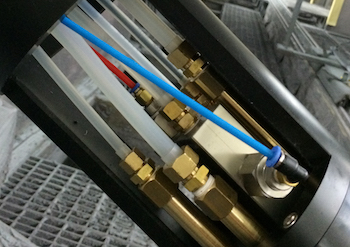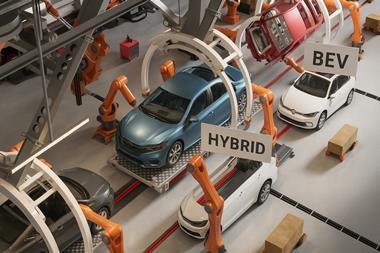
BAIC ZengCheng’s new plant is a typical example of perfect collaboration between a customer’s requirements and ABB’s expertise
 ABB Paint automation started in early 2000. It quickly became a leader in paint automation for all industries including tier one and GI with a special focus towards automotive, with more than 1,000 robots installed over the last ten years.As a turnkey supplier for OEMs able to provide the full robotic application in a painting line, ABB successes include many applications for most of China’s OEMs, including governmental, privately owned and joint-venture companies.ABB not only provides the standard high-quality system required by OEMs but also has a strong integration/customisation capability, making ABB able to serve the variable requirements and customisation from different customers, including high-end carmakers.
ABB Paint automation started in early 2000. It quickly became a leader in paint automation for all industries including tier one and GI with a special focus towards automotive, with more than 1,000 robots installed over the last ten years.As a turnkey supplier for OEMs able to provide the full robotic application in a painting line, ABB successes include many applications for most of China’s OEMs, including governmental, privately owned and joint-venture companies.ABB not only provides the standard high-quality system required by OEMs but also has a strong integration/customisation capability, making ABB able to serve the variable requirements and customisation from different customers, including high-end carmakers.
ABB’s capability to provide the full application system is demonstrated with its successful references in car body sealing, high-quality cosmetic sealing, robotic cleaning solution, car body painting including the latest-generation primerless process, interior car body painting in both tracking and stop-and-go mode and paint checker to ensure quality of painting.
 An original solutionBAIC ZengCheng may be used as a reference project where ABB can offer an original solution with compact but flexible layout with the whole painting process done with line tracking thanks to the use of six-axis IRB 5500 robots for both the painting process and hood/trunk opening and new-generation door openers on tracks.
An original solutionBAIC ZengCheng may be used as a reference project where ABB can offer an original solution with compact but flexible layout with the whole painting process done with line tracking thanks to the use of six-axis IRB 5500 robots for both the painting process and hood/trunk opening and new-generation door openers on tracks.
It is a typical example of perfect collaboration between the customer's requirements and ABB's expertise and unique technology to offer a cost-efficient solution both on CAPEX and OPEX with a high quality of application and availability thanks to the use of six-axis painting roots.
This new plant with a capacity of 150,000 vehicles per year, mainly passenger cars and SUVs, was realised in 2012. The original and traditional painting process was optimised by ABB in close collaboration with BAIC by using the latest generation of robotic technology for an overall reduction of the painting zone of 50% and therefore a significant reduction of the total cost of ownership for BAIC.
Several scenarios were offered by ABB from the very traditional stop-and-go solution to a moving line with special tooling on the doors to avoid additional openers. After detailed evaluation with the customer, a solution was agreed that keeps the advantage of the moving line without any investment for special tooling thanks to the use of door openers on tracks and elevated robots for hood and trunk opening.
The advantages of this design were:• compatibility with the existing footprint design• a flexible mix of production from small cars to large SUVs, thanks to variable pitch• increased reliability by six-axis painting robots only• one kind of painting robot and configuration for the whole line (inside, outside, primer, basecoat, clearcoat, allowing easy control of the station and equipment, common spare parts, etc• the combination of moving line with elevated robot with large accessibility, allowing reduction of the footprint by 50% versus the traditional solution• pattern control, allowing the quick change of spray pattern size for increased transfer efficiency, reduced cycle time and paint overspray and increased paint quality.
In addition, the customer also realised benefits such as:
• a short ramp-up time, with full production and quality reached within one month• reduced paint consumption by 25-35% for internal painting compared with original manual painting• reduced VOC (volatile organic content) emissions by same the value• improved quality and stability of the quality, thanks to the automation of the painting process• reduced time for the introduction of new models/colours• an increased first run rate compared with manual painting• high reliability and quality consistency, thanks to robotic technology• energy savings of 50%, thanks to footprint reduction and lower downdraft air velocity• the high level of automation cuts manpower to 20 people per shift for a production of 100,000• car bodies per year• return of investment for the new paintshop in fewer than three years.
South Korea and the 60% saving challengeSouth Korean automotive parts manufacturer Ecoplastic has stringent demands when it comes to implementing robotic atomiser painting technology – a challenge which the local ABB Robotics service team gladly accepted.

In South Korea, 370km southeast of Seoul, the coastal city of Gyeong-ju is located among widespread low mountains at the East Sea of Korea. Commonly referred to as “the museum without walls”, the city has become one of the country’s major tourist destinations. While tourism remains the dominant source of income in the region, the growing automotive supplier industry plays an ever-increasing role, now accounting for close to one-third of the city’s businesses. Established in 1984, Ecoplastic manufactures and sells automotive plastic parts, including bumpers and trims, wheel covers, back panels, radiator grilles, tailgate garnishes, rear garnishes, roof racks, consoles, and instrument panels. Customers are mostly domestic and include Hyundai, Kia and Hyundai Mobis.
The relationship with ABB harks back to 1993 when Ecoplastic purchased 20 ABB robots for bumper painting. Since then, ABB has been a regular supplier of consumables, new innovative technologies and state-of-the-art products for the company, including four IRB 580 robots for flaming plasma used in the pretreatment of bumper surfaces. Since 2010, ABB has also installed 16 atomiser minibel-021 sets for basecoat and clearcoat painting, with the most recent four installed in March 2015.
To avoid impacting production, the South Korean ABB Robotics service team installed the four atomisers over the course of four Sundays, which are normally reserved for cleaning and maintenance. Additional preparations prior to installation included optimising the atomiser size to avoid having to modify robot programming, checking the Tool Centre Point (TCP) and Shape of Paint Volume, designing the body shape and assembling the atomiser minibel-021, and finally checking the feedback rotation signal and shape air input.
 Easier cleaning and maintenance regimes with the new atomisers mean a 60% saving in Ecoplastic's annual operating costs
Easier cleaning and maintenance regimes with the new atomisers mean a 60% saving in Ecoplastic's annual operating costs“Contributing factors to why ABB was awarded the contract was our wide atomiser product line plus our extensive know-how in the area of plastic painting,” says Young-Woo Lee, project manager, ABB South Korea.“Faced with existing atomisers close to the very end of their lifecycle, time was of the essence,” says Heung-Jae Lee, painting maintenance team manager, Ecoplastic.
“While we are not using high voltage in painting, the additional challenge was to identify the best atomiser that could meet our stringent needs. ABB’s atomiser minibell offered the perfect solution and more in pricing, fast installation, durability and low running cost. We managed to overcome one of the largest obstacles, that is, to ensure the compatibility between the atomiser and the present equipment. Thanks to ABB Korea and my co-workers, we did it.”
The new atomisers from ABB will pay dividends for Ecoplastic in reduced cleaning and maintenance time, thereby reducing the annual operating cost by a staggering 60% – clearly a huge benefit and a great outcome for our own service team.








































